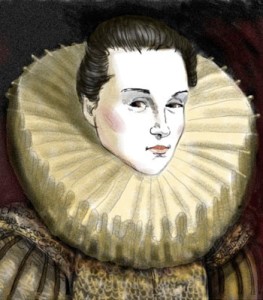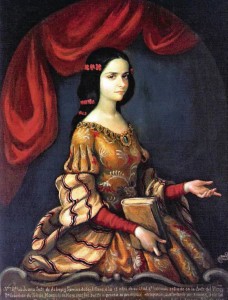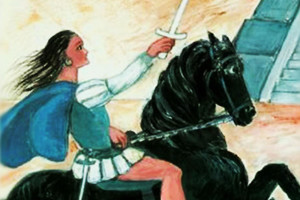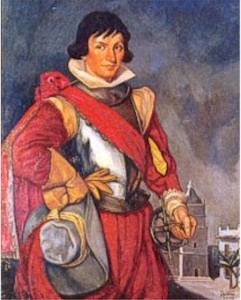Spanish Conquistadors Women
Mention the Spanish conquest of the New World and the names of illustrious Conquistadors come to mind: Hernán Cortés, who brought down the Aztec empire; Francisco Pizarro, the conqueror of Peru; and a host of grim-faced, bearded men in breastplates and steel bonnets who made the perilous Atlantic crossing in the 16th and 17th centuries in search of plunder and glory.
But what of Isabel Barreto, Spain’s first and only female Admiral of the Imperial Fleet? What is known to history of Inés Suárez, who accompanied her famous lover Pedro de Valdivia in the conquest of Chile, and fought with the army in the siege of Santiago? Then there was María de Estrada, another valiant warrior, who battled – sword in hand – alongside Cortés during the ‘Sorrowful Night’ massacre of Tenochtitlan. And towering above them all stood Catalina de Erauso, the ‘lieutenant-nun’, as fearsome a fighter as any man, whose exploits earned the praise of King Felipe III and Pope Urban VIII.
 Of course, none of these people, men or women, would have set sail for America had it not been for the most powerful Spanish woman of all, Queen Isabel of Castile, who ruled in her own right and not as the consort of her husband King Fernando of Aragón. It was Isabel who encouraged Columbus to establish an overseas empire for the newly unified kingdom of Spain, and it was she who provided the funds for his first voyage. And this from the country that gave the world the word ‘machismo’.
Of course, none of these people, men or women, would have set sail for America had it not been for the most powerful Spanish woman of all, Queen Isabel of Castile, who ruled in her own right and not as the consort of her husband King Fernando of Aragón. It was Isabel who encouraged Columbus to establish an overseas empire for the newly unified kingdom of Spain, and it was she who provided the funds for his first voyage. And this from the country that gave the world the word ‘machismo’.
By the end of the 15th century, in Spain as elsewhere in Europe, the male population had been decimated by decades of constant warfare, from the Hundred Years’ War (ending in 1453) to the final expulsion of the Moors from Granada in 1492. At that time, a Spanish woman found herself faced with two choices in life: find a partner among the dearth of available men, or don the habit.
New World Amazons
The discovery of America changed this panorama by opening up opportunities for adventure and personal enrichment in the New World. In this scenario, women began to take on a protagonist role hitherto unimaginable for the ‘weaker’ sex. Married women embarked from Seville with their soldier husbands, while others took to the sea in search of matrimony in the colonies, very much in the mould of the British memsahibs who two centuries later would sail to India hoping to snare an officer of good family. As a result, in the apex years of Spain’s imperial expansion, women came to account for nearly 30% of the voyagers to the New World colonies.
More than 500 years after Columbus’s first voyage to America – or Las Indias, the name by which the colonies were erroneously known – ‘the story we are told completely ignores the role of women’, says Spanish Rear-Admiral Gonzalo Rodríguez González-Aller. ‘The denial of a female presence only serves to reinforce the Black Legend and the stereotype of the bloodthirsty Conquistador, with no mention of the crucial female legacy.’
Many of these women displayed a remarkable strength of character, refusing to be left on terra firma while their husbands went to wage war overseas. Shortly before Pedro Arias Dávia was to lead the largest Spanish expedition to the New World (19 vessels and 1,500 men) in 1514, the general received a letter from his wife Isabel de Bobadilla demanding to be taken on the voyage. ‘Wherever fortune may lead you,’ she wrote, ‘be it on the furious waves of the sea or to face horrible dangers on land, I shall be by your side. I offer you the choice: cut my throat with your sword or agree to take me with you.’
Isabel de Barreto – Señora captain
 Isabel de Barreto was the wife of Alvaro de Mendaña, who had been appointed captain-general of the Solomon Islands. In 1596, she joined her husband’s expedition to the South Pacific archipelago, but en route they were battered by storms so severe that only one of the four galleons reached the islands. Some of the crew mutinied when the gold and pearls they had been promised failed to materialize. Wielding a machete, Isabel fought alongside her husband to put down the rebellion. The mutineers were overcome, but Mendaña was killed in the battle. The survivors, many of them struck down by malaria, elected Isabel to skipper the sole remaining warship onward to the Philippines.
Isabel de Barreto was the wife of Alvaro de Mendaña, who had been appointed captain-general of the Solomon Islands. In 1596, she joined her husband’s expedition to the South Pacific archipelago, but en route they were battered by storms so severe that only one of the four galleons reached the islands. Some of the crew mutinied when the gold and pearls they had been promised failed to materialize. Wielding a machete, Isabel fought alongside her husband to put down the rebellion. The mutineers were overcome, but Mendaña was killed in the battle. The survivors, many of them struck down by malaria, elected Isabel to skipper the sole remaining warship onward to the Philippines.
Thus Isabel acquired her late husband’s rank of fleet admiral. ‘Isabel de Barreto took the ship from the Solomon Islands to the Philippines, and the sufferings endured on this journey put her leadership abilities to the test,’ says historian Mariela Beltrán. ‘She took charge of the galleon and imposed an iron-clad discipline on the crew. The few who reached the Philippines alive remained there, where Isabel remarried Captain Fernando de Castro, a knight of the Order of Santiago.’
No less courageous a woman was Inés Suárez, the mistress of Pedro de Valdivia, the Spanish Crown’s governor of Chile. Suárez earned her warrior fame in the defence of the city of Santiago in 1541. Several Indian chieftains had been taken prisoner in the siege, and Suárez, standing in as military commander of the garrison while Valdivia was off fighting elsewhere, took her sword and decapitated the prisoners. She hurled their heads over the walls at the attackers, who fled in terror. On his return to liberated Santiago, Valdivia awarded his lover a medal for bravery.
Maria de Estrada – Swashbuckling women
 Maria de Estrada’s military prowess was of truly epic proportions. On the night of 30 June 1520, Hernán Cortés and his followers were forced to fight their way out of Tenochtitlan (the present-day Mexico City) when it was discovered that the Aztec king Moctezuma II, a hostage of the Spaniards, had been treacherously murdered. Maria de Estrada, who accompanied the Spanish troops, brandished her sword with such fury that, as noted in contemporary chronicles, ‘she exceeded the efforts of any man’.
Maria de Estrada’s military prowess was of truly epic proportions. On the night of 30 June 1520, Hernán Cortés and his followers were forced to fight their way out of Tenochtitlan (the present-day Mexico City) when it was discovered that the Aztec king Moctezuma II, a hostage of the Spaniards, had been treacherously murdered. Maria de Estrada, who accompanied the Spanish troops, brandished her sword with such fury that, as noted in contemporary chronicles, ‘she exceeded the efforts of any man’.
Estrada survived the massacre of up to 800 Spanish soldiers who fled the city that night, and left no doubt in her memoirs as to the tenacity of the female fighting spirit. ‘It is not right for Spanish women to allow their husbands to go to fight on their own. The Indians must be made to understand that the Spanish are so brave, even their women know how to wage war.’
The most extraordinary woman swashbuckler of them all was Catalina de Erauso, who in 1600, at the age of 15, escaped her convent to wander the streets of her native San Sebastián, which she had never seen in her life. Erauso fled into the woods, where she cut her hair short and fashioned a shirt and trousers out of her blue habit, taking the name Francisco Loyola. She reached the port of Bilbao, where she was jailed for a month for having beaten senseless several boys who had taunted her in the street.
That was when Erauso decided to set sail for the New World rather than risk being unmasked and sent back to the convent. As luck would have it, the ship’s captain turned out to be her uncle, who failed to recognise her. She signed on, and when they were docked in Cartagena de las Indias, loading a cargo of silver for the return journey, in her own words ‘I struck my uncle a hard blow when he was asleep, relieving him of 500 pesos’. She leapt ashore and went to seek her fortune elsewhere in the colonies.
Catalina de Erauso
 Erauso’s further exploits read like an Indiana Jones adventure tale. In a shop in Lima she was attacked by three men who had not reckoned on her fighting skills. She killed two of the men, and escaped to Lima, later enlisting in a regiment that was off to campaign in Chile. At the port of Concepción she came across the governor’s secretary, who turned out to be a brother she had not seen since she was given up to the convent at the age of four. Erauso later killed him, by accident she claims, in a battle at night.
Erauso’s further exploits read like an Indiana Jones adventure tale. In a shop in Lima she was attacked by three men who had not reckoned on her fighting skills. She killed two of the men, and escaped to Lima, later enlisting in a regiment that was off to campaign in Chile. At the port of Concepción she came across the governor’s secretary, who turned out to be a brother she had not seen since she was given up to the convent at the age of four. Erauso later killed him, by accident she claims, in a battle at night.
In Chile, Erauso’s column came under attack by Indians, who overran the town of Valdivia. ‘We counterattacked and did battle with them three or four times,’ she recounts in her autobiography. ‘They slew many of our troops and made off with our standard.’ Erauso gave chase with a few soldiers, ‘trampling and killing, and receiving some damage to myself. She took a spear thrust in the shoulder and three arrow wounds. But she returned with the regimental colours and was promoted to the rank of lieutenant.
In another battle, she unhorsed the Indian chief and ‘I immediately had him hanged from a tree’. She later plunged her sword into the heart of a fellow officer who accused her of cheating at cards, and she was arrested for killing a man in another duel but escaped torture by virtue of being a Basque, who were exempt under Inquisition law.
The Bishop of Lima, having determined that she was a virgin (we are not told how he acquired that piece of intelligence), allowed Erauso to return to Spain. She was received and decorated at Court by King Felipe III, and in Rome Pope Urban VIII granted her permission to continue her life dressed as a man, ‘charging me to live honestly henceforth and to abstain from offending my neighbours’.
The last entry in Erauso’s memoirs has her in Naples, where on the wharf she became the butt of a joke by a group of girls. The girls made themselves scarce when Erauso threatened them with ‘a hundred whacks on the head and a hundred slashes to whomever may wish to defend you’.
